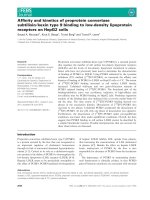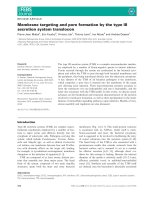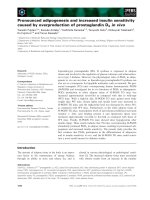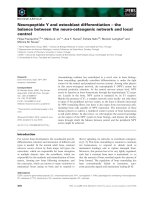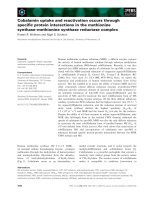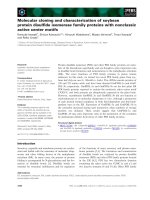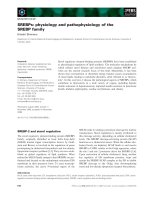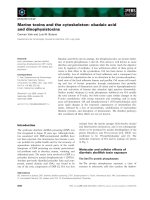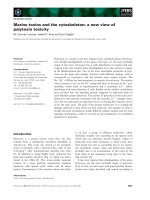Báo cáo khoa học: Cytoglobin conformations and disulfide bond formation pdf
Bạn đang xem bản rút gọn của tài liệu. Xem và tải ngay bản đầy đủ của tài liệu tại đây (421.59 KB, 9 trang )
Cytoglobin conformations and disulfide bond formation
Christophe Lechauve
1
,Ce
´
dric Chauvierre
1
, Sylvia Dewilde
2
, Luc Moens
2
, Brian N. Green
3
, Michael
C. Marden
1
, Chantal Ce
´
lier
1
and Laurent Kiger
1
1 Inserm U779, Universite
´
s Paris VI et XI, Le Kremlin-Bice
ˆ
tre, France
2 Department of Biomedical Sciences, University of Antwerp, Belgium
3 Waters MS Technologies Centre, Micromass UK Ltd., Altrincham, Cheshire, UK
Introduction
The vertebrate heme globin family has been extended
to include two new members, neuroglobin (Ngb) and
cytoglobin (Cygb), which differ in structure, tissue
distribution and function [1–3].
Cygb is expressed at varying concentrations in many
body tissues, such as connective tissue, fibroblasts and
neurons [3–5]. The cellular localization of Cygb is
atypical; it is present in the cytoplasm of almost all cell
types; it is also found in the cytoplasm and nucleus of
neuronal cells [4,6]. The physiological role of Cygb
remains unknown, although several roles have been
proposed, such as the protection of cells from oxida-
tive-related damage during ischemic reperfusion injury
following hypoxia [7,8], the metabolism of NO in tis-
sues [9], and collagen synthesis [4,10]. It has also been
reported that Cygb plays a role in cancer as a tumor
suppressor gene; indeed, it was observed that the pro-
moter region of Cygb is hypermethylated and under-
expressed in tumors [11].
Cygb is considered to be in a clade with vertebrate
myoglobin (Mb) and shares about 30% amino acid
sequence identity with Mb, implying a common evolu-
tionary ancestry [3]. Human Cygb is composed of 190
amino acids with the presence of extended N- and
C-terminal regions of about 20 residues each. The crys-
tal structure of this globin is characteristic of the clas-
sical three-over-three a-helical globin fold in the core
region of each subunit, and the asymmetric unit of the
crystals contains two molecules of Cygb [12,13]. Cygb
contains two exposed cysteine residues (Cys B2 and
Cys E9), suggesting the possibility of inter or intra-
molecular disulfide bridge formation.
Spectroscopic studies have shown that Cygb belongs
to the class of hexacoordinated globins, for which the
Keywords
disulfides, globins, kinetics, ligand binding,
light scattering
Correspondence
L. Kiger, INSERM – U779, 78 rue du
Ge
´
ne
´
ral Leclerc, Ho
ˆ
pital de Bice
ˆ
tre Bat.
Broca, Niveau 3, 94275 Le Kremlin Bice
ˆ
tre,
France
Fax: (33) 1 49 59 56 61
Tel: (33) 1 49 59 56 64
E-mail:
(Received 18 February 2010, revised 8 April
2010, accepted 13 April 2010)
doi:10.1111/j.1742-4658.2010.07686.x
The oligomeric state and kinetics of ligand binding were measured for
wild-type cytoglobin. Cytoglobin has the classical globin fold, with an
extension at each extremity of about 20 residues. The extended length of
cytoglobin leads to an ambiguous interpretation of its oligomeric state.
Although the hydrodynamic diameter corresponds to that of a dimer, it
displays a mass of a single subunit, indicating a monomeric form. Thus,
rather than displaying a compact globular form, cytoglobin behaves hydro-
dynamically like a tightly packed globin with a greater flexibility of the
N- and C-terminal regions. Cytoglobin displays biphasic kinetics after the
photolysis of CO, as a result of competition with an internal protein
ligand, the E7 distal histidine. An internal disulfide bond may form which
modifies the rate of dissociation of the distal histidine and apparently leads
to different cytoglobin conformations, which may affect the observed
oxygen affinity by an order of magnitude.
Abbreviations
Cygb, cytoglobin; DLS, dynamic light scattering; Mb, myoglobin; Ngb, neuroglobin; SEC-MALLS, size exclusion chromatography with multi-
angle laser light scattering.
2696 FEBS Journal 277 (2010) 2696–2704 Journal compilation ª 2010 FEBS. No claim to original US government works
binding of an external gaseous ligand to heme requires
the dissociation of an internal protein residue (His E7);
both ligands are in competition for the distal heme bind-
ing site. A biphasic pattern was observed, as expected
for a hexacoordinated model of competition between
two ligands for a single binding site [14]. In this study,
we re-examined the structure–function relationships of
Cygb, as several questions have been raised concerning
the basic properties of Cygb, namely the role of the
disulfide bond in protein function and its involvement in
the tertiary and quaternary structures.
Results and Discussion
Quaternary structure analysis of human Cygb by
size exclusion chromatography with multi-angle
laser light scattering (SEC-MALLS) and DLS
The theoretical molar mass of Cygb is 21 404 Da. Cygb
has been characterized previously by SEC as a dimeric
protein [12,14]. The elution volume measured by SEC is
directly related to the hydrodynamic radius of the pro-
teins, and is generally correlated with the logarithm of
the molar mass. The Cygb multimeric state was initially
determined using molar mass markers belonging to the
globin protein family, but this established method
depends on the reliability of the size of the markers and
may not be accurate in the absolute molar mass deter-
mination. For this reason, we used static light scatter-
ing (MALLS) for the determination of the molar
masses of the different Cygb protein species in solution.
SEC-MALLS analysis gave a molar mass of
21 400 ± 100 Da for Cygb in solution (Fig. 1A). It
should be noted that this method does not rely on
reference proteins.
We also estimated the hydrodynamic diameter using
two independent instruments (Malvern Instruments,
Malvern, Worcestershire, UK and Wyatt Technology,
Santa Barbara, CA, USA); it was found to be indepen-
dent of the redox and ligation states of Cygb. The
hydrodynamic diameter versus molar mass was plotted
for Cygb (5.2 nm), together with several globular pro-
teins (Fig. 1B). It appears that this size parameter
value for Cygb does not correlate well with the linear
relationship found between the hydrodynamic diameter
and molar mass for other proteins belonging to the
globin family. SEC confirmed that the N- and C-termi-
nal extensions of Cygb ( 20 residues each) are
responsible for a large increase in hydrodynamic vol-
ume for Cygb relative to a globular protein. A trun-
cated Cygb of approximately 17 kDa, without the
extensions, exhibits similar hydrodynamic properties to
those of ‘classical’ globins (Fig. S1).
These results explain the misinterpretation of the
Cygb quaternary assembly arising from gel filtration
experiments based only on a putative relationship
between the hydrodynamic volume and molar mass
[12,14]. It should also be noted that electrostatic
repulsion (or attraction) forces between the proteins
and column packing may contribute to a deviation
from an ideal elution behavior based only on the
hydrodynamic diameter, in this case for globular pro-
teins. The N- and C-terminal residue segments of
Cygb were not clearly resolved in two of the X-ray
crystal structures [12,13]. In another structure display-
ing covalently bound dimer through two intermolecu-
lar disulfide bridges [15], the extensions formed an
additional a-helix and an ordered loop, respectively,
A
B
Fig. 1. (A) Molar mass determination of Cygb using SEC-MALLS:
the thin full curve represents the relative UV absorbance at
280 nm; the bold line corresponds to the molar mass estimated
from the light scattering profile and concentration measurement;
both versus the elution time. (B) Correlation between the hydrody-
namic diameters (measured by dynamic light scattering; Malvern
Instruments and Wyatt Technology) and molar masses of six globu-
lar proteins (monomeric a-globin, Ngb, Mb, tetrameric hemoglobin
and octameric hemoglobin). The Cygb (red) hydrodynamic diameter
deviates from the correlation line of other globin proteins.
C. Lechauve et al. Cytoglobin conformations and disulfide bond formation
FEBS Journal 277 (2010) 2696–2704 Journal compilation ª 2010 FEBS. No claim to original US government works 2697
but not in a symmetrical way, as only one extremity
is well defined in each subunit. Thus, the conforma-
tional flexibility of both terminal regions may explain
the increase in hydrodynamic diameter relative to
other globins.
Mass spectrometry assessment of Cygb disulfide
bonds and general structure
The results obtained by MALLS were complemented
by electrospray ionization mass spectrometry (ESI-
MS). When analyzed under conditions that should
retain the noncovalent bonds for globin assembly [14],
the dominant species was monomeric Cygb, together
with approximately 5% dimeric Cygb. A solution of
Cygb with dithiothreitol, a thiol reducing agent, ana-
lyzed under denaturing conditions, showed predomi-
nantly a monomer with a mass of 21 404.7 ± 0.3 Da
(sequence mass 21 404.7 Da) and no dimer (Fig. 2A).
When this solution was incubated at 37 °C and pH 8
after dithiothreitol removal, the mass of Cygb progres-
sively decreased over 7 h to 21 402.6 ± 0.3 Da
(Fig. 2B), implying the formation of an intramolecular
disulfide bond (calculated mass 21 402.7 Da). Also pres-
ent was a minor component (not shown) of mass
42 805.3 ± 5 Da ( 5% of Cygb), which is consistent
with a Cygb dimer formed by one or two intermolecular
disulfide bonds between two Cygb monomers
(calculated masses of 42 807.3 and 42 805.3 Da, respec-
tively). As expected, when the solution of Cygb used to
produce Fig. 2B was reduced with dithiothreitol, the
mass of the Cygb monomer reverted to 21 404.7 ±
0.3 Da (Fig. 2C), and the putative dimer disappeared.
These results confirm the occurrence of mainly mono-
meric Cygb with an intramolecular disulfide bridge.
Crystallographic structure
The initial crystallographic structures of Cygb were
described as dimers [12,13]. There are major differences
between these two structures. One was obtained from
a mutated protein without cysteines [Cys38(B2)Ser and
Cys83(E9)Ser mutant], whereas the other protein con-
tained the native cysteines. An asymmetric unit includ-
ing two globins is observed for Cygb, and does not
necessarily imply a dimeric form in dilute solutions.
However, Sugimoto’s dimeric structure (pdb 1V5H
[13]), with two intermolecular disulfide bridges, is not
present significantly in our results, which show mono-
meric Cygb with an intramolecular disulfide bridge at
protein concentrations of 0.1–20 lm. Structure com-
parison shows a difference at the position of Cys B2,
with the distance between Ca atoms for residues B2
and E9 of 7.35 A
˚
in de Sanctis’ structure (pdb 1UM0
Reduced Cygb
Oxidized Cygb
Reduced Cygb
A
B
C
Fig. 2. ESI-MS analyzed under denaturing conditions of: (A) a solution of reduced Cygb; (B) solution in (A) after 7 h of incubation at 37 °C
under aerobic conditions, pH 8; (C) solution in (B) after reduction with dithiothreitol.
Cytoglobin conformations and disulfide bond formation C. Lechauve et al.
2698 FEBS Journal 277 (2010) 2696–2704 Journal compilation ª 2010 FEBS. No claim to original US government works
[12]) and 12.0 A
˚
in Sugimoto’s structure (Fig. 3). There
is a loss of one turn of the B-helix in Sugimoto’s struc-
ture, with Cys B2 moving away from the Cys E9 posi-
tion, which would not allow an intramolecular
disulfide bridge (Fig. 3). The buried interface surface
of Sugimoto’s structure [13] is half that (640 A
˚
2
) found
for another Cygb dimeric structure (2DC3 [15]) exhib-
iting the same intermolecular disulfide bonds. In this
latter crystal structure, in addition to the fact that only
one terminal sequence was ordered in each monomer
(one a-helix and one ordered loop motif), structural
differences were also found in the conformation of
certain residues in the vicinity of heme.
Ligand binding of human Cygb
Cygb shows the characteristic absorption spectra
(Fig. S2) and ligand binding for the hexacoordinated
globins. The kinetics of ligand binding to Cygb after
the photodissociation of CO shows the form expected
for hexacoordinated globins (Fig. 4A). The rapid
bimolecular phase corresponds to the competitive
binding between CO and the internal histidine
residue (His E7). For the fraction binding histidine,
the return to the final (CO-bound) state involves the
slow dissociation of histidine. A previous study [16]
has reported a single exponential decay, probably
because the observation time was not sufficiently long
for histidine dissociation and replacement by CO.
E9
B2
Fig. 3. Two Cygb crystallographic structures, superimposed by the
full sequence method of DS-Visualizer (Accelrys), which takes into
account all common atoms of the aligned globins. The residues dis-
played correspond to the position for the cysteine pair (B2 and E9)
and the distal and proximal histidines (E7 and F8) in Cygb. The
structure in red of human Cygb was obtained by Sugimoto et al.
[13] (1V5H) and the structure in green (B2 and E9 in purple) was
obtained by De Sanctis et al. [12] with a mutated protein (1UMO)
without cysteines: Cys38(B2)Ser and Cys83(E9)Ser.
B
A
Fig. 4. Flash photolysis kinetics for Cygb at 25 °C. (A) Recombina-
tion kinetics at different CO concentrations [from top to bottom:
0.01, 0.1 and 1 atm CO (760 Torr)]. After flash photolysis of CO,
the first phase represents competitive binding between CO and
histidine to the heme sites. The second phase is a slow replace-
ment reaction of histidine by CO to return to the preflash state.
The broken lines are simulations using the model for competitive
ligand binding. (B) Kinetic curves of the slow phase. Samples with
dithiothreitol (DTT)-reduced Cygb show a single form (also
observed for the mutant Cygb without cysteines). The cysteine oxi-
dized form, which can form an internal S–S bond, displays a faster
replacement reaction; however, heterogeneity is observed, indicat-
ing the presence of two protein conformations. The rapid phase
arising from the competition between CO and histidine for heme
rebinding (with an observed rate equal to the sum k
CO
on
+ k
His
on
) is the
same for samples with or without DTT.
C. Lechauve et al. Cytoglobin conformations and disulfide bond formation
FEBS Journal 277 (2010) 2696–2704 Journal compilation ª 2010 FEBS. No claim to original US government works 2699
By analyzing the data from experiments performed
at different CO concentrations, one can extract the
rates for CO and histidine association, as well as those
for histidine dissociation [14,17]. Results from experi-
ments with a mixed CO–O
2
atmosphere allow a deter-
mination of the O
2
binding rates. The intrinsic O
2
or
histidine dissociation is quite slow, requiring about 1 s
(Fig. 4A).
Overall, the kinetics show the same form as for
Ngb, although the ligand association rates to Cygb are
slower than those to Ngb. As this occurs for both oxy-
gen and histidine, the overall oxygen affinity remains
on the order of 0.1–10 Torr at 25 °C, which is a
common range of O
2
affinity measured for the hexaco-
ordinated globins. For both Cygb and Ngb, the slow
oxygen and histidine dissociation rates compensate for
the effect on the overall oxygen affinity. In the case of
Ngb, there is a shift in the observed oxygen affinity
from about 1 to 10 Torr on reduction of the cysteines;
the internal mechanism is mainly caused by a change
in the histidine dissociation rate. Cygb shows a similar
effect, with the oxygen affinity changing from about
0.2 to 2 Torr (Fig. 5); however, the transition only
occurs for about one-half of the molecules.
The major change in kinetics of Cygb after the addi-
tion of dithiothreitol, known to reduce cysteines and
therefore to break S–S bonds, is shown in Fig. 4B.
Although the cysteine-reduced form shows homoge-
neous kinetics, there is heterogeneity of the histidine
dissociation rate for the protein solution exposed to O
2
after purification. Two histidine dissociation rates
are measurable, each representing about one-half of
the sample, and differ by a factor of 10 (Fig. 4B,
Table 1), whereas the other binding parameters are
little changed.
This heterogeneity could not be eliminated by vari-
ous preparations from different laboratories or by
changing the temperature and pH conditions. It thus
appears to be a basic property of Cygb samples. One
can then question whether there is an interconversion
of the two conformations. Any interconversion of the
conformations is apparently slow, as the ligand bind-
ing and Fe
2+
oxidation kinetics (which occur on the
order of several minutes) display distinct phases for
the two forms. Indeed, a partial autoxidation under air
of the heme iron results in an enhancement of the
higher oxygen affinity fraction (the more slowly oxidiz-
ing form) as assessed by flash photolysis (data not
shown).
The stopped-flow data for the replacement reaction
indicate a further complexity. For samples with and
without dithiothreitol, at least two rates were observed
(this work) [18]. This could indicate several possible
conformations for the distal histidine, and only certain
of these forms are apparent when the sample has been
incubated in the His-Fe-His state. As seen in the
P
50
(Torr)
0.1
1
10
100
Cygb S-S
Oxygen affinity
Cygb
T-state HbA
Mb
R-state HbA
Ngb S-S
Ngb
Fig. 5. Synthesis of the oxygen affinity for the various allosteric
states of members of the globin family. For Ngb and Cygb, the oxy-
gen affinity, conserved for various species, falls within the physio-
logical range, supporting a role for oxygen delivery.
Table 1. Kinetic parameters determined from flash photolysis. DTT, dithiothreitol; WT, wild-type.
Protein
k
CO
on
(lMÆs
)1
)
k
O
2
on
(lMÆs
)1
)
k
O
2
off
(s
)1
)
K
O
2
(nM)
k
His
on
(s
)1
)
k
His
off
(s
)1
) K
His
P
O
2
50
(Torr)
Cytoglobin WT with DTT 0.65 2.5 0.9 35 140 1.5 90 1.8
Doubly mutated Cygb without Cys 0.65 2.5 0.9 35 180 1.5 120 2.4
Cytoglobin WT with S–S bridge
Conformation 1 0.65 2.5 0.9 35 130 0.9 140 2.8
Conformation 2 0.65 2.5 0.9 35 130 12 11 0.2
Experimental conditions: 50 m
M phosphate buffer at pH 7.0, 25 °C. The O
2
solubility coefficient was taken as 1.82 lMÆTorr
)1
. Note the
distinction between the intrinsic affinity K
O
2
= k
off
⁄ k
on
(as for pentacoordinated forms) and the overall affinity observed for the ligand compe-
tition of the hexacoordinated globins K
O
2
=(k
off
⁄ k
on
) ⁄ (1 + K
His
).
Cytoglobin conformations and disulfide bond formation C. Lechauve et al.
2700 FEBS Journal 277 (2010) 2696–2704 Journal compilation ª 2010 FEBS. No claim to original US government works
structural images (Fig. 3), at least two distinct posi-
tions for Cys(B2)38 can be observed for Cygb without
the internal disulfide bond; this residue may thus adopt
various intermediate positions which may influence the
ligand binding kinetics.
A slow relaxation process might explain the two
conformations as, in the stopped-flow experiments, the
protein is incubated in the His-Fe-His state for at least
several minutes. It should be noted that no change in
the proportion of the kinetic phases was observed after
repeated photolysis of the hexacoordinated form over
5 s by a series of laser pulses at 10 Hz to remove the
CO ligand (for samples equilibrated under a 5% CO
atmosphere), meaning that slow relaxation between the
Cygb conformations does not take place within a time-
scale of seconds. We also measured by stopped flow
the histidine replacement by CO, starting from the
hexacoordinated ferric form. Using a double mixing
sequence, one can first reduce the iron and then incu-
bate Cygb in the ferrous hexacoordinated state for var-
ious delay times before mixing with CO to probe the
histidine to CO replacement reaction. No difference
was observed for incubation times ranging from milli-
seconds to seconds, meaning that the redox state of
iron does not influence the Cygb conformation in the
bis-histidyl bound state. As the rapid phase of the his-
tidine to CO replacement reaction seems to be most
characteristic of the flash photolysis method, this spe-
cial state could depend on the recent history of binding
of an external ligand.
For both Cygb and Ngb [14], the disulfide bond
influences the final position of the E-helix, which, in
turn, modifies the affinity for the distal histidine. As
the overall O
2
affinity depends on histidine binding,
this leads to a modification in O
2
affinity. The mecha-
nism in Ngb involves a disulfide bond in the CD loop
region which influences the position of the E-helix. For
Cygb, a more direct mechanism can be envisaged from
the structure: the Cys E9 and the distal His E7 are on
opposite sides of the E-helix (Fig. 3); thus formation
of the E9–B2 bond should pull directly on His E9.
This change in conformation could also perturb the
local molecular dynamics, which may influence ligand
binding.
Cygb presents the same features as Ngb; however,
the sample with S–S bonds is not homogeneous. Only
about one-half of the signal corresponds to a high dis-
sociation rate for histidine and, consequently, one-half
to a low dissociation rate, the slow rate being similar
to that measured in the absence of the disulfide bridge
(Fig. 4B). For both Ngb and Cygb, this transition is
reversible: reduction of the protein by dithiothreitol
leads to a single kinetic species, and the re-oxidation
of cysteines (to re-form the disulfide bridge) again
exhibits heterogeneous kinetics.
This reduction after the addition of 2 mm dithiothre-
itol takes a few minutes at 37 °C based on the CO
binding kinetics, whereas S–S bridge formation under
air is achieved after 7 h as measured by mass spectros-
copy (Fig. 2). Therefore, a faster formation of the
disulfide bond, necessary for a physiological role,
would probably require the presence of a catalyst.
A catalyst of disulfide bridge formation that acts with
a coupling reaction between both redox centers,
namely heme and cysteines, could also be considered.
Whatever the putative partner responsible for cysteine
oxidation, the reverse reduction is probably performed
by glutathione. The highly concentrated glutathione
redox couple (GSH ⁄ GSSG) is known to be displaced
towards the reduced form in the cytosol, whereas, in
the endoplasmic reticulum, most of the constitutive
disulfide bridges are usually formed in secretory pro-
teins. Therefore, the equilibrium for disulfide bridge
formation in Cygb will be influenced by the redox state
of the cytosol, which may also be transiently influ-
enced by reactive oxygen species or other oxidative
species derived from nitric oxide. It should be noted
that intracellular compartments may provide favorable
local environments in which the thiol redox state may
be different from that of the bulk cytoplasm, but also
that Cygb can be present elsewhere in the nucleus [6].
Conclusion
In conclusion, human Cygb is monomeric in solution,
as measured by MALLS, at micromolar concentrations
of heme, the range expected for Cygb in vivo. The
molar mass of Cygb samples measured by SEC-
MALLS, mass spectrometry and flash photolysis con-
firms the possibility of formation of an intramolecular
disulfide bridge. The formation of an intermolecular
disulfide bridge was observed in mass spectrometry,
but represents only a small fraction of the Cygb prepa-
ration and is negligible in the kinetic analysis. A con-
formational transition in Cygb between an oxidized
(intramolecular disulfide bond) form and a reduced
(disulfide free) Cygb form is evident in the kinetics;
such a transition affects the E-helix position, allowing
a fine modulation of the endogenous His E7 affinity
for heme binding. Disulfide bridge formation probably
creates a significant stress on the E-helix of Cygb,
resulting in a change in the distal histidine end-position
of the liganded and unliganded states, as well as in its
movement for heme binding. A constraint provided by
the disulfide bridge creates two possible positions of
distal histidine after photodissociation, leading to
C. Lechauve et al. Cytoglobin conformations and disulfide bond formation
FEBS Journal 277 (2010) 2696–2704 Journal compilation ª 2010 FEBS. No claim to original US government works 2701
heterogeneity of kinetics. After breaking the S–S bond,
the histidine relaxes towards a stable conformation,
and kinetic curves show a clean biphasic form, as
expected for the competition model of two ligands with
one affinity for histidine. It can be proposed, as for
Ngb [14], that, on oxidative stress, a change in the local
redox state in response to physiological stimuli may
induce the rupture and ⁄ or formation of the intramolec-
ular B2–E9 disulfide bond in Cygb, thus initiating a
conformational change that affects the overall oxygen
affinity (Fig. 5) and other sensing functions as well.
Materials and methods
Expression and purification of recombinant Cygb
The expression of wild-type human Cygb and the doubly
mutated Cygb C38S ⁄ C83S mutant was performed as
described previously [19]. The truncated CYGB differs from
the wild-type by the removal of the amino-terminal residues
1–17 and the carboxyl-terminal residues 165–190, as
described previously [14]. Inclusion bodies were solubilized
in 6 m guanidinium hydrochloride and, after elimination of
the insoluble material, Cygb was reconstructed by adding
free hemin and dialyzed overnight. The samples were then
purified with an Akta purifier system (GE Healthcare, Life-
sciences, Uppsala, Sweden) on a Hitrap DEAE Sepharose
column (GE Healthcare, Lifesciences, Uppsala, Sweden).
The concentrated material was loaded onto a Superose 12
HR 16 ⁄ 50 column (GE Healthcare). The final purity of the
pooled Cygb was checked by absorbance spectra and SDS-
PAGE.
Dynamic light scattering
The particle size was measured with a Zetasizer Nano-ZS
(Malvern Instruments), based on dynamic light scattering.
Size distribution by volume was used for data interpreta-
tion. Measurements were performed at 20 °C in 100 mm
NaCl, 30 mm phosphate buffer at pH 7.5, in triplicate on
each sample, and the average was taken for the diameter.
Size exclusion by fast protein liquid
chromatography and MALLS
The Cygb shape and molar mass in solution were deter-
mined using online SEC-MALLS. The gel filtration separa-
tion was carried out using an EttanÔ LC liquid
chromatography system (GE Healthcare) equipped with a
SuperoseÔ 12 HR 10 ⁄ 300 GL column (GE Healthcare).
Isocratic elution was performed at a flow rate of
0.39 mLÆmin
)1
using a mobile phase of 30 mm NaCl ⁄ P
i
(pH 7.5), 150 mm NaCl and 0.03% sodium azide at 25 °C.
It should be noted that NaCl was added to the elution buf-
fer to avoid unwanted interactions between proteins and
the solid phase. Light scattering analysis was performed
using an EttanÔ LC HPLC system with automatic degasser
and thermostatically controlled autosampler, connected
inline to a DAWN
Ò
HELEOSÔ II 18-angle static light
scattering detector, equipped with a QELS (quasi-elastic
light scattering) instrument (Wyatt Technology) and an
Optilab
Ò
rEX differential refractometer, equipped with a
Peltier temperature-regulated flow cell maintained at 25 °C
(Wyatt Technology). Calibration of the light scattering
detector was subsequently verified using an albumin mono-
mer standard (Sigma-Aldrich, Copenhagen, Denmark),
recombinant Ngb, Mb (Sigma-Aldrich, Copenhagen, Den-
mark), Mb dimer, diaspirine cross-linked (DCL) hemoglo-
bin tetramer (Baxter Healthcare Corporation, Deerfield, IL,
USA) and an octameric recombinant hemoglobin based on
the natural variant hemoglobin Ta-Li [20]. The molar mass
for the protein was calculated from the light scattering data
using a specific refractive index increment (dn ⁄ dc) value of
0.183 mLÆg
)1
. The light scattering on the different detectors
was analyzed using astra v software (Wyatt Technology,
version 5.3.4.13) to finally obtain the absolute molar mass
and the hydrodynamic diameter for the eluted fractions.
Sample preparation and ESI-MS
Native samples were infused (5 LÆmin
)1
) into the mass spec-
trometer (Quattro Ultima, Micromass Ltd., Wythenshawe,
UK) at a concentration of approximately 5 lm in 1 : 1 ace-
tonitrile–water containing 0.2% formic acid. Data were
acquired over the mass-to-charge ratio (m ⁄ z) range 600–
2000 (5 min) and deconvoluted to present the spectra on a
molar mass scale using the maximum entropy (maxent)-
based software supplied with the spectrometer. Mass scale
calibration employed the series of ions with multiple
charges from separate introductions of Mb (sequence mass
16 951.5 Da).
Spectra and ligand binding
⁄
dissociation kinetics
Spectral measurements were made with a Varian Cary 400
(Varian, Inc., Palo Alto, CA, USA) or an HP 8453 diode
array spectrophotometer (Hewlett Packard, Bracknell,
UK). All ligand binding experiments were performed in
30 mm phosphate buffer at pH 7.5 with (10 mm) or without
dithiothreitol to reduce the cysteine residues.
The binding kinetics after heme ligand photolysis were
performed using an Nd:YAG laser CFR-300 (Quantel, Les
Ulis, France) generating 8 ns pulses of 160 mJ at 532 nm.
The laser beam, as well as the monochromatic detection light,
were brought to the sample cuvette by an optical fiber. The
methods used to assess the hexacoordination and bimolecu-
lar CO and O
2
rate constants have been described previously
[17]. Samples from 1 to 10 lm on a heme basis were placed in
4mm·10 mm quartz cuvettes. We also used a SFM-3
Cytoglobin conformations and disulfide bond formation C. Lechauve et al.
2702 FEBS Journal 277 (2010) 2696–2704 Journal compilation ª 2010 FEBS. No claim to original US government works
stopped-flow rapid mixing equipment (Bio-logic SAS, Claix,
France) to study ligand replacement. Experiments were
repeated at least three times for each sample condition.
Acknowledgements
We thank Professors T. Burmester (University of
Hamburg) and T. Hankeln (University of Mainz) for
the Cygb plasmid, and Veronique Baudin-Creuza
(Inserm U779) for the octameric recombinant hemo-
globin sample. This work was supported by Inserm,
DGA (De
´
le
´
gation Ge
´
ne
´
rale pour l’Armement) contract
N° 07.34.004, and Universite
´
s Paris VI et XI.
References
1 Burmester T, Weich B, Reinhardt S & Hankeln T
(2000) A vertebrate globin expressed in the brain. Nat-
ure 407, 520–523.
2 Kawada N, Kristensen DB, Asahina K, Nakatani K,
Minamiyama Y, Seki S & Yoshizato K (2001) Charac-
terization of a stellate cell activation-associated protein
(STAP) with peroxidase activity found in rat hepatic
stellate cells. J Biol Chem 276, 25318–25323.
3 Burmester T, Ebner B, Weich B & Hankeln T (2002)
Cytoglobin: a novel globin type ubiquitously expressed
in vertebrate tissues. Mol Biol Evol 19, 416–421.
4 Schmidt M, Gerlach F, Avivi A, Laufs T, Wystub S,
Simpson JC, Nevo E, Saaler-Reinhardt S, Reuss S,
Hankeln T et al. (2004) Cytoglobin is a respiratory
protein in connective tissue and neurons, which is
up-regulated by hypoxia. J Biol Chem 279, 8063–
8069.
5 Nakatani K, Okuyama H, Shimahara Y, Saeki S, Kim
DH, Nakajima Y, Seki S, Kawada N & Yoshizato K
(2004) Cytoglobin ⁄ STAP, its unique localization in
splanchnic fibroblast-like cells and function in organ
fibrogenesis. Lab Invest 84, 91–101.
6 Geuens E, Brouns I, Flamez D, Dewilde S, Timmer-
mans JP & Moens L (2003) A globin in the nucleus!
J Biol Chem 278, 30417–30420.
7 Fordel E, Thijs L, Martinet W, Lenjou M, Laufs T,
Van Bockstaele D, Moens L & Dewilde S (2006)
Neuroglobin and cytoglobin overexpression protects
human SH-SY5Y neuroblastoma cells against oxida-
tive stress-induced cell death. Neurosci Lett 410, 146–
151.
8 Hodges NJ, Innocent N, Dhanda S & Graham M
(2008) Cellular protection from oxidative DNA damage
by over-expression of the novel globin cytoglobin
in vitro. Mutagenesis 4, 293–298.
9 Halligan KE, Jourd’heuil FL & Jourd’heuil D (2009)
Cytoglobin is expressed in the vasculature and regulates
cell respiration and proliferation via nitric oxide dioxy-
genation. J Biol Chem 284, 8539–8547.
10 Hankeln T, Ebner B, Fuchs C, Gerlach F, Haberkamp
M, Laufs TL, Roesner A, Schmidt M, Weich B,
Wystub S et al. (2005) Neuroglobin and cytoglobin in
search of their role in the vertebrate globin family.
J Inorg Biochem 99, 110–119.
11 Shivapurkar N, Stastny V, Okumura N, Girard L, Xie
Y, Prinsen C, Thunnissen FB, Wistuba II, Czerniak B,
Frenkel E et al. (2008) Cytoglobin, the newest member
of the globin family, functions as a tumor suppressor
gene. Cancer Res 68, 7448–7456.
12 De Sanctis D, Dewilde S, Pesce A, Moens L, Ascenzi P,
Hankel T, Burmester T & Bolognesi M (2004) Crystal
structure of cytoglobin: the fourth globin type discov-
ered in man displays heme hexa-coordination. J Mol
Biol 336, 917–927.
13 Sugimoto H, Makino M, Sawai H, Kawada N,
Yoshizato K & Shiro Y (2004) Structural basis of
human cytoglobin for ligand binding. J Mol Biol 339,
873–885.
14 Hamdane D, Kiger L, Dewilde S, Green BN, Pesce A,
Uzan J, Burmester T, Hankeln T, Bolognesi M, Moens
L et al. (2003) The redox state of the cell regulates the
ligand binding affinity of human neuroglobin and cyto-
globin. J Biol Chem 278, 51713–51721.
15 Makino M, Sugimoto H, Sawai H, Kawada N,
Yoshizato K & Shiro Y (2006) High-resolution struc-
ture of human cytoglobin: identification of extra N- and
C-termini and a new dimerization mode. Acta Crystal-
logr D62, 671–677.
16 Trent JT III & Hargrove MS (2002) A ubiquitously
expressed human hexacoordinate hemoglobin. J Biol
Chem
277, 19538–19545.
17 Uzan J, Dewilde S, Burmester T, Hankeln T, Moens L,
Hamdane D, Marden MC & Kiger L (2004) Neuroglo-
bin and other hexacoordinated hemoglobins show a
weak temperature dependence of oxygen binding.
Biophys J 87, 1196–1204.
18 Smagghe BJ, Sarath G, Ross E, Hilbert JL & Hargrove
MS (2006) Slow ligand binding kinetics dominate
ferrous hexacoordinate hemoglobin reactivities and
reveal differences between plants and other species.
Biochemistry 45, 561–570.
19 Dewilde S, Mees K, Kiger L, Lechauve C, Marden
MC, Pesce A, Bolognesi M & Moens L (2008) Expres-
sion, purification, and crystallization of neuro- and
cytoglobin. Methods Enzymol 436, 341–357.
20 Baudin-Creuza V, Chauvierre C, Domingues E, Kiger
L, Leclerc L, Vasseur C, Ce
´
lier C & Marden MC (2008)
Octamers and nanoparticles as hemoglobin based blood
substitutes. Biochim Biophys Acta 1784, 1448–1453.
Supporting information
The following supplementary material is available:
Fig. S1. Partition coefficients measured by gel filtration.
C. Lechauve et al. Cytoglobin conformations and disulfide bond formation
FEBS Journal 277 (2010) 2696–2704 Journal compilation ª 2010 FEBS. No claim to original US government works 2703
Fig. S2. Absorbance spectra of Cygb.
This supplementary material can be found in the
online version of this article.
Please note: As a service to our authors and readers,
this journal provides supporting information supplied
by the authors. Such materials are peer-reviewed and
may be re-organized for online delivery, but are not
copy-edited or typeset. Technical support issues arising
from supporting information (other than missing files)
should be addressed to the authors.
Cytoglobin conformations and disulfide bond formation C. Lechauve et al.
2704 FEBS Journal 277 (2010) 2696–2704 Journal compilation ª 2010 FEBS. No claim to original US government works
